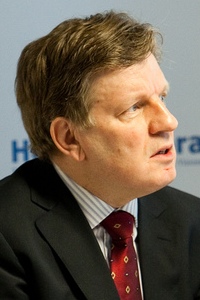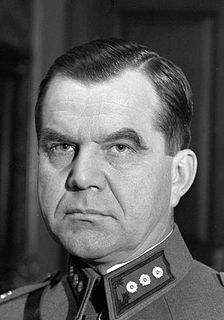
Martti Juhani Miettunen, was a Finnish politician who served twice as Finland's prime minister, from 1961 to 1962 and again from 1975 to 1977.

Toivo Mikael Kivimäki, (J.D.), was a Finnish politician of the National Progressive Party who served as the head of the department of civil law at Helsinki University 1931–1956, Prime Minister of Finland 1932–1936, and Finland's Envoy to Berlin 1940–1944.

The Finnish Government is the executive branch and cabinet of Finland, which directs the politics of Finland and is the main source of legislation proposed to the Parliament. The Government has collective ministerial responsibility and represents Finland in the Council of the European Union. In the incumbent Marin Cabinet, the Government comprises 19 ministers leading 12 ministries.

The first cabinet of Paavo Lipponen was the 66th government of Finland, which existed from 13 April 1995 to 15 April 1999. The cabinet’s Prime Minister was Paavo Lipponen. It was a majority government, and one of the longest-running governments in Finnish history. Lipponen's first government ran for a whole term of a Finnish cabinet, or 1 464 days in total. The cabinet was composed of a coalition formed by the Social Democratic Party, the National Coalition Party, the Swedish People's Party, the Left Alliance, and the Green League. Due to the cabinet containing five separate parties from all over Finland's political spectrum, both of Lipponen's cabinets were considered rainbow coalitions.
The cabinet of Anneli Jäätteenmäki was the 68th government of Finland. The cabinet was in office from 17 April 2003 to 24 June 2003. It was a majority coalition government headed by Prime Minister Anneli Jäätteenmäki. The cabinet was formed by three parties: the Centre Party, the Social Democratic Party, and the Swedish People's Party.

Juho Heikki Vennola was Professor of National Economics at the University of Helsinki, a member of the Parliament of Finland, and a politician from the National Progressive Party, who served as Prime Minister of Finland twice.

The cabinet of Esko Aho was the 65th government of Finland. The cabinet existed from 26 April 1991 to 13 April 1995. The cabinet’s Prime Minister was Esko Aho.

Johan Wilhelm (Jukka) Rangell was the Prime Minister of Finland from 1941 to 1943.
Lauri Ingman's first cabinet was the third Government of independent Finland and the first to be officially designated as Government (valtioneuvosto) instead of Senate (senaatti). The cabinet's time period lasted from November 27, 1918 to April 17, 1919, following the surrender of Germany and the consequent republican transformation of the Finnish form of state.
Fagerholm's first cabinet was the 32nd government of Finland, which lasted from 29 August 1948 to 17 March 1950. It was a minority government headed by Social Democratic Prime Minister Karl-August Fagerholm.

Carl Henrik Wolter Ramsay was a Finnish politician and an economist from the Swedish People's Party. Ramsay is mostly remembered for the fact that he was sentenced in the war-responsibility trials in 1946.

The cabinet of Juha Sipilä was the 74th government of Finland, from 2015 to 2019. It was formed following the parliamentary election of 2015 and formally appointed by President Sauli Niinistö on 29 May 2015. From June 2017, the cabinet consisted of a coalition formed by the Centre Party, Blue Reform and the National Coalition Party. The cabinet's Prime Minister was Juha Sipilä.
Teuvo Aura's second cabinet was the 54th government of Finland, which existed from 29 October 1971 to 23 February 1972. It was a caretaker government whose Prime Minister was Teuvo Aura.

Keijo Liinamaa's cabinet was the 57th government of Finland. The cabinet existed for 171 days, lasting from 13 June 1975 to 30 November 1975. The Liinamaa cabinet was a caretaker government drawn by President Urho Kekkonen. Due to this government having been instituted by the President, the government included no politically affiliated parties, consisting instead only of government employees. The cabinet’s Prime Minister was Keijo Liinamaa.
Rafael Paasio's second cabinet was the 55th government of Finland. The administration ran from 23 February 1972 to 4 September 1972. It was a minority government formed by the Social Democratic Party.

The third cabinet of Kalevi Sorsa was the 62nd government of Finland. The majority government lasted from 19 February 1982 to 6 May 1983. The cabinet's prime minister was Kalevi Sorsa. The Finnish People's Democratic League disapproved of the government's decision to raise the country's defence budget, which led to a governmental crisis, which culminated in the FPDL being forced to resign from the government by the prime minister on 31 December 1982. As a result of the change, the Liberal People's Party joined the coalition and, together with the rest of the previous government, formed the Sorsa IIIb Cabinet.

Sorsa's fourth cabinet was the 63rd government of Finland, which existed for 1 456 days, from 6 May 1983 to 30 April 1987. The government’s Prime Minister was Kalevi Sorsa. It was a majority government based on the ”red-soil government” model, as it was a coalition formed by the Social Democrats, the Centre Party, the Swedish People’s Party, and the Rural Party.
The second cabinet of Martti Miettunen was the 58th government of Finland, which lasted from 30 November 1975 to 29 September 1976. It was a majority government formed by the Centre Party, the Social Democrats, the Finnish People's Democratic League, the Swedish People's Party, the Liberals, and some unaffiliated politicians. The cabinet's Prime Minister was Martti Miettunen.

The cabinet of Harri Holkeri was the 64th government of Finland, which existed from 30 April 1987 to 26 April 1991. It was a majority government formed by the National Coalition Party, the Social Democratic Party, the Swedish People's Party, and the Rural Party. The cabinet's Prime Minister was Harri Holkeri. The Rural Party left the coalition in August 1990 because it disagreed with the government's pension funding plan.

The cabinet of Antti Rinne was the 75th government of Finland. It was formed following the parliamentary election of 2019 and was formally appointed by President Sauli Niinistö on 6 June 2019. The cabinet consisted of a coalition formed by the Social Democratic Party, the Centre Party, the Green League, the Left Alliance, and the Swedish People's Party. The cabinet's Prime Minister was Antti Rinne.














